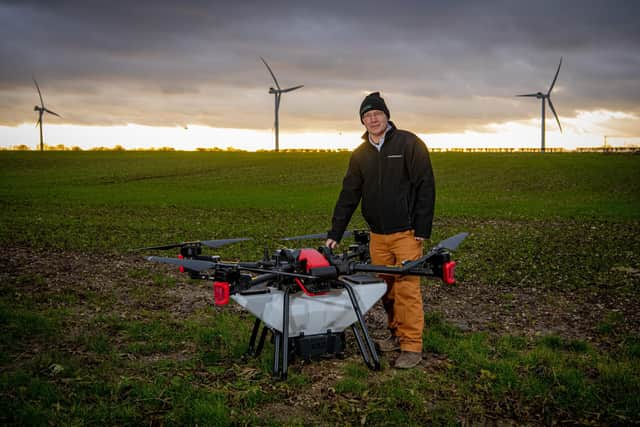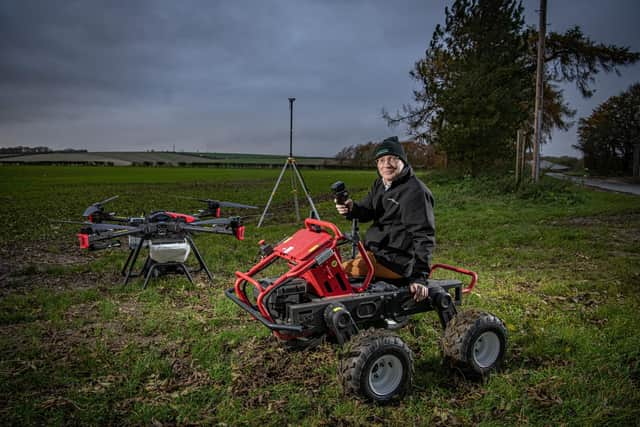Meet the Yorkshire agribusinessman who is selling drones to farmers
Andrew Manfield, of Hessleskew Farm, Sancton, near Market Weighton, is at the forefront of helping fellow farmers with the right technology through his business, Manterra.
Last week he was at Agritechnica in the German city of Hanover, taking in the latest ideas and developments.
Advertisement
Hide AdAdvertisement
Hide AdHe says new drone technology will facilitate much more cost-effective application control, that precision farming is being aided by retro fitting of technology but there is still one element that farmers should never forget – walking in their fields.


He said: “We are looking to enable people to implement the best new technology, where they can see how it can save money and give extra productivity and how it can improve the working environment for them and their operators.
“Efficiency of fertiliser application has never been more vital than the past two years when fertiliser prices have skyrocketed.
“We are doing a lot of retro fitting of new technology to older machines where people who can’t afford new, but can buy new technology for an existing machine.”
Advertisement
Hide AdAdvertisement
Hide AdHe sees drone technology as the next new advancement in that it will provide savings in precision, machinery and time.


“What’s really exciting with drone technology is we’re able to facilitate variable rate application with no longer the need to drive up and down every tram line with expensive heavy machinery.
“Because it is airborne it just zips from one marked area on the map to another and performs in the blink of an eye. It flies two and a half metres above the crop and can carry 50 litres or 50 kilos of product.
“Working with our partners, we already have permission for our first heavy-lift agricultural drone. It has a three-metre blade span and an application area of between 3-10 metres.
Advertisement
Hide AdAdvertisement
Hide Ad"It is fully automated and when the battery is getting low the drone flies back for a recharge. It can apply product while travelling at 10km per hour and fly back at 25-30km per hour.”
Andrew says he is impressed with its progress.
“It’s coming much faster into regular use than I anticipated. Its main commercial use at present is greenhouse whitewashing.
“In agriculture there is already some success where a crop not easily accessed with a machine, such as under-sowing a cover crop into a standing crop. Drones are great for anything that requires zonal application.
“There are ongoing negotiations with the pesticides-approval people to apply slug pellets by drone. A drone can sort it out in a matter of minutes.”
Advertisement
Hide AdAdvertisement
Hide AdAndrew says that precision farming is being taken up more readily.
“Autosteer is still a hugely important part of the precision-farming advances made in the past 20 years but there are still many who haven’t realised its full benefits, in terms of working better in poor visibility and in challenging working conditions.”
Andrew believes technology works hand-in-glove with experience and knowledge.
“People say the hard work is done in the office, so that the screen is pre-programmed to apply, but I would suggest the hard work is actually going out and ground truthing what you have done in the past and what you plan to do in the future.
Advertisement
Hide AdAdvertisement
Hide Ad“If for example you’re going to do variable rate seeding it’s important to go out into the field. You really need a good and committed approach to agronomy.
"It can’t all be done in the office and, like any good farmer would have done for centuries, you still need to go out and walk the field. Ground truth it.
“There are two calibrations when you get your machine ready. One is in the yard where you make sure a certain amount flows out over a certain time.
"The other is where you go andlook and see the reality of what isgrowing and how this relates to the digital mapping that you will have in the office.”
Advertisement
Hide AdAdvertisement
Hide AdOf this year’s new advances on show in Hanover, Andrew’s eye was caught by a new advancement that is solving problems with AdBlue, the additive used to clean up emissions in diesel vehicles.
He said: “There are problems with AdBlue crystalising. I came across a preformulated AdBlue while I was in Hanover that does not crystalise.”
Manterra is an independent business that Andrew says will work with anyone, whether farmers or agricultural machinery suppliers.